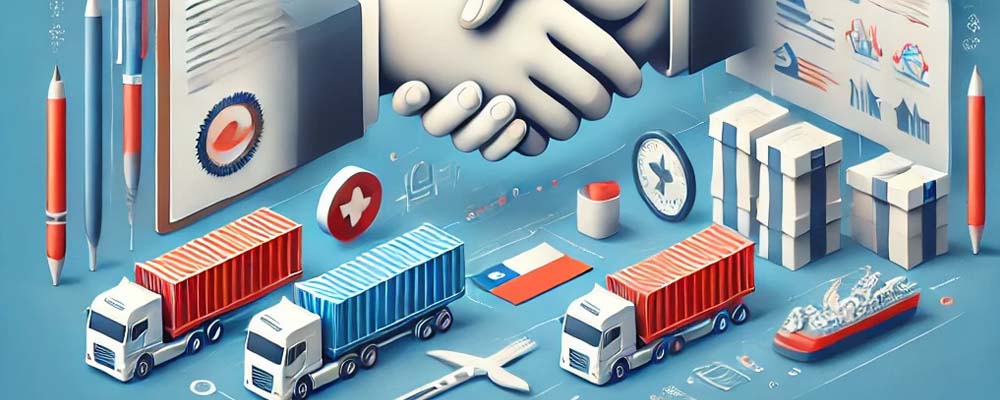
Chile is a growing and dynamic market for global exporters, offering many opportunities for businesses in various industries. Whether you’re involved in manufacturing, logistics, freight forwarding, or e-commerce, understanding the ins and outs of exporting to Chile can provide a competitive edge. In this comprehensive guide, we’ll explore everything you need to know about exporting to Chile, from trade regulations and procedures to market trends and logistics solutions.
Why Export to Chile?
Chile has been a vital trade partner for many countries, particularly due to its strategic location on the west coast of South America and its stable political and economic environment. The country is part of several trade agreements, making it easier for exporters to enter the Chilean market.
Some of the key industries in Chile include mining (especially copper), agriculture, fishing, and manufacturing. However, in recent years, sectors like technology, e-commerce, and renewable energy have also been growing rapidly. Exporters can benefit from Chile’s diversified economy and the demand for both raw materials and high-value-added products.
Key Reasons to Consider Exporting to Chile
- Strategic Location: Chile’s extensive coastline and proximity to the Pacific Ocean make it a gateway to the rest of Latin America and the Asia-Pacific region.
- Trade Agreements: Chile has a robust network of trade agreements, including Free Trade Agreements (FTAs) with the U.S., European Union, China, and many other countries.
- Stable Economy: Chile’s GDP has shown steady growth, and its low levels of corruption, transparency, and openness to international trade make it an attractive market.
- Growing Industries: From mining to renewable energy and e-commerce, Chile’s economy is diverse and offers opportunities in both traditional and emerging sectors.
1. Understanding Trade Agreements and Tariffs
Trade Agreements
Chile is a member of numerous trade agreements, which help reduce tariffs and simplify the export process. Some of the most notable agreements include:
- Trans-Pacific Partnership (CPTPP): Provides access to various Pacific Rim markets with reduced tariffs.
- Mercosur: Although Chile is an associate member rather than a full member, it benefits from trade agreements within this South American trade bloc.
- U.S.-Chile Free Trade Agreement: This agreement eliminates most tariffs on U.S. goods entering Chile, making it easier for American companies to export.
Chile’s strong involvement in global trade agreements allows for competitive pricing for exporters and facilitates smoother customs processes.
Tariffs and Duties
Thanks to its numerous trade agreements, Chile imposes relatively low tariffs on imports. For many goods, the general tariff rate is 6%, but depending on the product category and country of origin, this rate can be significantly reduced or even eliminated. It is crucial for exporters to verify specific tariffs based on the Harmonized System (HS) codes of their products.
Exporters should also be aware of value-added tax (VAT), which is currently set at 19% in Chile. While VAT is payable upon entry, businesses can reclaim VAT on exported goods, making proper documentation critical.
 2. Export Documentation Requirements for Chile
2. Export Documentation Requirements for Chile
Exporting to Chile requires specific documentation to ensure that your goods clear customs smoothly. Here’s a list of essential documents:
Essential Export Documents
- Commercial Invoice: This document must include detailed information about the goods, including description, price, quantity, and terms of sale.
- Bill of Lading (BOL): This serves as a contract between the exporter and the freight carrier and is required for shipping goods.
- Packing List: This document outlines the weight, volume, and contents of each shipment, helping customs inspectors understand what’s being imported.
- Certificate of Origin (COO): For many products, a COO is required to ensure preferential treatment under trade agreements.
- Import Declaration: The importer in Chile must file an Import Declaration form with Chilean customs to clear goods.
- Product-specific certificates: Depending on the nature of the goods being exported (e.g., agricultural products), certificates such as phytosanitary or veterinary certificates may be required.
Compliance with Chilean Standards
Many products entering Chile must comply with Chilean technical standards (Normas Chilenas, or NCh), particularly for consumer goods like electronics, food, and beverages. Understanding these standards is crucial to avoid delays or rejections at customs. Exporters can check specific product standards through the Instituto Nacional de Normalización (INN), Chile’s national standards body.
3. Logistics and Shipping Solutions for Chile
Chile’s geography, with its long coastline and mountainous regions, presents unique logistical challenges. Exporters need to carefully plan shipping routes, select appropriate ports, and work with reliable freight forwarding companies to ensure smooth delivery.
Major Ports in Chile
Chile boasts several modern ports, each specialized in different types of cargo:
- Port of San Antonio: The largest port in Chile, handling a significant portion of the country’s containerized cargo. It’s ideal for exporters shipping manufactured goods, consumer products, and raw materials.
- Port of Valparaíso: Known for its historical significance, Valparaíso handles bulk and container cargo, especially for food and agricultural exports.
- Port of Iquique: Serves as an entry point for goods going to the northern regions and neighboring Bolivia.
Inland Transportation
Chile’s extensive road and rail networks facilitate transportation to major cities and industrial areas. The Pan-American Highway runs through Chile, connecting the country with neighboring markets. For businesses shipping goods inland, working with reliable logistics providers with local expertise is crucial.
Freight Forwarding Options
Freight forwarders play a critical role in managing the complexities of shipping to Chile. They handle everything from documentation to transportation and customs clearance, ensuring that goods arrive on time and without issue. Exporters should work with forwarders familiar with the Chilean market and its regulatory requirements.
 4. Market Trends and Opportunities in Chile
4. Market Trends and Opportunities in Chile
Key Sectors for Exporters
Chile’s diverse economy offers numerous opportunities for exporters. Some of the most promising sectors include:
1. Mining and Equipment
Chile is the world’s largest copper producer, and mining is the backbone of the Chilean economy. Exporters of mining equipment, machinery, and related services are in high demand. Additionally, there is growing interest in sustainable mining practices, which opens opportunities for green technologies.
2. Agriculture and Food Products
Chile is a major exporter of fruits, vegetables, and seafood. However, the country also imports large quantities of agricultural equipment, fertilizers, and food processing technology. Exporters from these sectors have opportunities to tap into Chile’s agricultural market, particularly in regions where drought and other climate-related issues create demand for innovation.
3. Technology and E-commerce
The growth of Chile’s e-commerce sector has been driven by a tech-savvy population and increasing internet penetration. Chilean consumers are open to purchasing goods from abroad, especially electronics, fashion, and home goods. Exporters in the e-commerce space should prioritize fast shipping and compliance with local consumer protection laws.
4. Renewable Energy
Chile is positioning itself as a leader in renewable energy, particularly in solar and wind power. There are significant opportunities for exporters of renewable energy equipment, such as solar panels, wind turbines, and battery storage systems.
Trends to Watch
- E-commerce Boom: Chile’s e-commerce market is expected to continue growing, with an emphasis on faster delivery times and cross-border shopping.
- Sustainable Business: As Chile works towards its sustainability goals, businesses that offer eco-friendly products and services will have a competitive edge.
- Infrastructure Investment: Ongoing investment in Chile’s infrastructure, including ports and roads, will improve logistics options for exporters.
5. Challenges and Tips for Exporting to Chile
Common Challenges
Despite the many opportunities, exporters should be aware of the challenges they may face when entering the Chilean market:
- Geographical Barriers: Chile’s long, narrow geography can pose logistical challenges, particularly for businesses distributing goods throughout the country.
- Regulatory Complexity: Exporters must navigate complex regulatory frameworks, including Chile’s import standards, technical regulations, and product labeling requirements.
- Currency Fluctuations: The Chilean peso can fluctuate, affecting pricing strategies for exporters. Using forward contracts or hedging strategies can mitigate this risk.
Tips for Successful Exporting to Chile
- Research the Market: Understand the specific needs and preferences of Chilean consumers or businesses within your target sector.
- Partner with Local Agents: Having a local representative or distributor can help navigate regulatory and cultural differences.
- Stay Updated on Trade Agreements: Trade agreements can change over time, so staying updated on the latest developments ensures your business remains compliant and takes advantage of any new opportunities.
- Leverage Technology: For e-commerce businesses, providing localized websites and offering payment options preferred by Chilean consumers can increase sales.
 Conclusion
Conclusion
Exporting to Chile offers a wealth of opportunities for businesses in various industries, from mining and agriculture to technology and e-commerce. By understanding the country’s trade agreements, compliance requirements, and logistical challenges, exporters can enter the Chilean market with confidence. Partnering with experienced freight forwarders and local experts will ensure that your goods move smoothly through the supply chain, while staying informed about market trends and economic developments will keep you competitive in this growing market.
Chile is a country on the rise, and with the right strategy, exporters can benefit from its dynamic economy and strategic location as a trade hub for South America.
If you’re looking to expand your business into Chile, now is the time to get started. Contact us!




 2. Export Documentation Requirements for Chile
2. Export Documentation Requirements for Chile 4. Market Trends and Opportunities in Chile
4. Market Trends and Opportunities in Chile Conclusion
Conclusion



